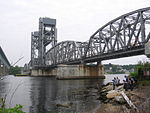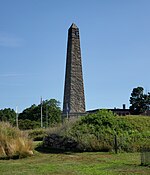Gold Star Memorial Bridge
1943 establishments in ConnecticutBridges completed in 1943Bridges completed in 1973Bridges in New London County, ConnecticutBridges of the United States Numbered Highway System ... and 7 more
Bridges on the Interstate Highway SystemBridges over the Thames River (Connecticut)Interstate 95Road bridges in ConnecticutSteel bridges in the United StatesU.S. Route 1Use mdy dates from September 2019

The Gold Star Memorial Bridge is a pair of steel truss bridges that carry both Interstate 95 and U.S. Route 1 across the Thames River between New London, Connecticut, US and Groton, Connecticut. The bridge is the largest structure in the state with more than 1,000,000 sq ft (93,000 m2) of deck area, and the longest bridge in the state at 6,000 feet (1,829 m). Its 11 highway lanes accommodate an average daily traffic of 117,000 vehicles. The bridge is actually a set of twin bridges, but they are generally spoken of using the singular "bridge;" the local media and residents refer to it as "The Goldstar".
Excerpt from the Wikipedia article Gold Star Memorial Bridge (License: CC BY-SA 3.0, Authors, Images).Gold Star Memorial Bridge
Jewish War Veterans Memorial Highway,
Geographical coordinates (GPS) Address External links Nearby Places Show on map
Geographical coordinates (GPS)
| Latitude | Longitude |
|---|---|
| N 41.364166666667 ° | E -72.0875 ° |
Address
Gold Star Memorial Bridge
Jewish War Veterans Memorial Highway
06640 , City of Groton
United States
Open on Google Maps








